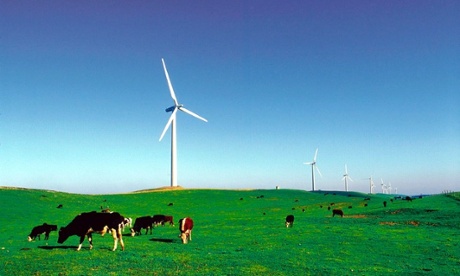Renewable energy target thrown into confusion as negotiations collapse
Labor walks away from RET talks, saying it cannot accept ‘deep and devastating cut to the sector’ being proposed by Coalition

The ALP considers the gap between its negotiating position on the RET and that of the Coalition to be too big to overcome.
Photograph: Pacific Hydro Limited/AAP
Attempts to strike a bipartisan deal on the renewable energy target
have collapsed, throwing a central climate policy into confusion as the
government prepares to welcome world leaders to the G20 summit on the
weekend.
Labor’s environment spokesman, Mark Butler, wrote to the industry
minister, Ian Macfarlane, on Tuesday saying his party could not accept
the “deep and devastating cut to the sector” being proposed by the
government and didn’t see “any value in continuing discussions at this
point in the time.”
With Macfarlane overseas, the timing of the letter appears partly
designed to embarrass the government ahead of the G20, but it is also an
indication that the ALP considers the gap between its negotiating
position and that of the Coalition to be too big to overcome.
The policy currently requires that 41,000 gigawatt hours of energy
come from renewables by 2020. Labor and the renewables industry rejected out of hand
the government’s opening gambit in the talks – to reduce the target to
about 26,000 gigawatts – saying it would decimate the industry.
It is understood Labor indicated it would negotiate around a target
in the mid to high 30,000 gigawatt hours, but this was unacceptable to
the government.
The government is already under pressure from US and European
negotiators to give climate change a higher profile at the G20 meeting,
to help momentum towards an ambitious agreement for post-2020 emissions
reduction targets at the United Nations summit in Paris at the end of
next year.
And the EU has already agreed to cut carbon emissions by “at least
40%” by 2030 based on 1990 levels with “at least” 27% of energy sourced
from renewable sources by 2030.
Labor’s walkout from the talks sets up a high stakes stand-off.
Without a renewable energy target, Australia’s new Direct Action climate
policy will have little chance of meeting even the minimum target of a
5% cut in emissions by 2020, according to modelling firm Reputex. But
investment in renewables will also grind to a halt and existing
investments will come under pressure as the value of the market created
by the RET remains unviably low.
In his letter Butler says “Labor will not stand by and watch billions
of dollars of investment in the Australian renewable energy sector –
along with thousands of jobs – go overseas because of deep cuts in the
target.”
And he says that since the abolition of the carbon tax, “the importance of a strong RET cannot be overstated”.
But research released by the Climate Council this week showed
investment in the RET had already fallen by 70% since 2013 because of
uncertainty surrounding its future.
The government had originally signaled it wanted even deeper cuts to
the target – which was intended to deliver 20% renewables by 2020 but
due to declining energy demand will now deliver more like 27%. It
commissioned businessman and self-professed climate sceptic Dick
Warburton to undertake a review. Its main recommendation was for the
target to be slashed to about 16,000 gigawatt hours.
But after fierce resistance from industry and concerted criticism of
that review, the federal cabinet asked the environment minister, Greg
Hunt, and the industry minister, Ian Macfarlane, to try to reach a
bipartisan agreement about the future of the program that would allow
continued investment without fear of policy change.
Macfarlane said the government wanted a target representing a “real”
20% of the current energy market – probably about 26,000 gigawatt hours –
with no change to the subsidies for household rooftop solar panels and a
full exemption from the scheme for all energy-intensive industries,
such as aluminium, copper, zinc and cement.

No comments:
Post a Comment